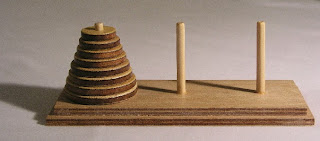Tuesday, May 12, 2015
Second semester summery
Repeating decimals.
Tower of hanoi mathmatical induction.
the other lesson was about mathmatical induction. This looks really complecated at first, but it is actually not when you get it. First, we need to prove true for n=1, we compare the left and right hand side. After that, we assume true for n=k, and we need to show true for k+1. In this step, we replace all the k with k+1. And we simplify. we rplace the k term with the step when we assume k=n. And we simplify the problem and we would get same things on both sides and that is thw ultimate goal.
Trig review week
This week we reviewed trigonometry. We went over all the trig identities. After reviewing, I became more fimiliar with the identities. I memorized the most impirtant ones and it helped me with many problems. For example, the proving type of questions. Those were exremely hard for me when we first learn it because I never remembered the identities, it was hard for me to recall any when doing the problem so it creates more difficulties. The most troubling part of trig is the double angles for me. They are still confusing and I hope I can figure them out soon. the unit circle is very handy when doing trig problems as well, and I am trying to memorize it.
Parametric equations
Parametric equations of a curve express the coordinates of the points of the curve as functions of a variable, called a parameter. When given a problem, there are x and y variables and also a parameter t. In order to eliminate the parameter, we have to use elimination or substitution the do so. If the equations involves trig, we would have to use the trig identities to help eliminating the parameter. If we want to graph a parametric equation, we first draw a number box of x, y, and t. The problems are given a limit of the parameter t, we pick numbers between the limit and we get the values of x and y from equations given. Last, we plot the points. We have to remember to mark the starting point and the direction of the graph. And we connect the points.
Monday, May 11, 2015
Partial fraction
Partial fraction is the process of separating a term into its original form. A+b+c. when looking at a problem, the first thing to do is to factor the denomenator. After determining whether the factors are linear or nonlinear. If the term is linear, we put a variable A on top of a factor. If it is not, we put ax+b. After this, we multiply the greatest common denomenator to the whole thing. And we factor out the x s and we set systems of equations to solve for A,B,C. Finally, we write the answer out. If the power of denomonator is less than the numerator, we have to do long division first.
Sequence and series.
A sequence is consist with elements and a list of numbers. a series is a list of numbers adding together. There are wo types of sequence and series , arithmetic and geometric. Arithmatic means that the elements are related by addition. Geometeic means that the slements are related by multiplication. Arithmetic formula is An= A1+(n-1)d. A1represents the first term of the series. And d is the difference between two terms. N means the nth term. Geometric formula is An=A1*r^(n-1) A1is the first term and r is the rate of two terms. We can get r by dividing any two terms next to each other. We can write eries into summation formation.
Graphing systems of inequalities
Systems of inequalities are similar to the system of regular equations. It is composed of few equations and it has answers that satisfy the equations. We first graph the indevidule graphs in the system. secondly, we need to determine which side of the graph satisfy the inequality. We can determine this by testing a point on the graph. The final answer will be the area on the graph which all graphs overlap.
Cramer's rule
Cramer's rule helps to make solving systems if equations easier. Because the variables are eliminated and we can just deal with numbers. First, we put coeficients in matrix form and we take the determinate of that. And we find Dx or Dy by placing the answer colume to the variable. We take determinate of DY and Dx. Thus, x=Dx/D and same for other variables.








